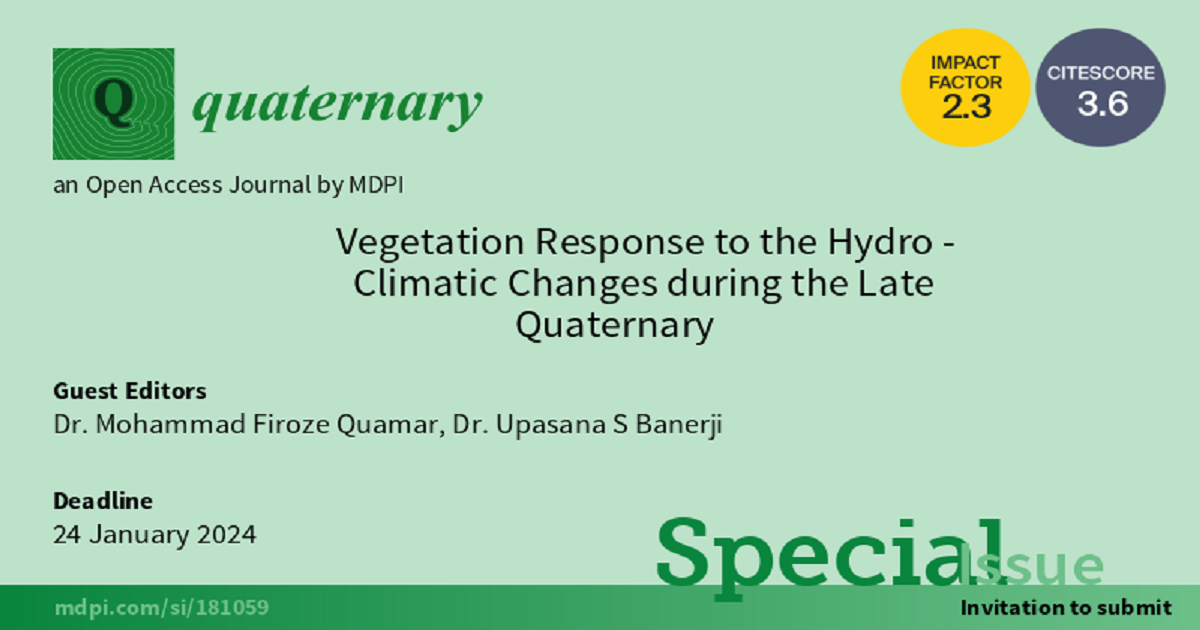- 2.1Impact Factor
- 4.1CiteScore
- 39 daysTime to First Decision
Vegetation Response to the Hydro-Climatic Changes during the Late Quaternary
Special Issue Information
Dear Colleagues,
Vegetation is one of the main climatic reservoirs of the Earth; the other four climatic reservoirs being the atmosphere, ocean, land surfaces and cryosphere. The global distribution and composition of vegetation is largely controlled by the climate (precipitation, temperature), soil characteristics and altitude; however, human and natural impacts are also present. Simultaneously, climate change is most evidently reflected in vegetation because the vegetation of any area is an integral and basic composition of the ecosystem, which is sensitive to and governed by the climatic changes. The influence of climate on vegetation is so great that each climatic zone has its own characteristic vegetation type. Therefore, plants are among the best indicators of environmental and climatic changes, both temporally and spatially. Pollen gains and spores are produced by plants, and the widespread transport and mixing of pollen grains by wind or water generally form pollen assemblages, which represent characteristics of the vegetation, climatic conditions or sedimentary environment at a specific time or area.
Understanding climate change and monsoonal variability is a defining issue of our time, and various geological, biological, historical and archaeological proxies provide evidence for ways in which the Earth’s climate has changed (in the past) and may do so in the future. Among the biological proxies, palynology has proved to be one of the most potent tools for the reconstruction of vegetation-based past climatic changes. Therefore, it is crucial to study the response of vegetation (dynamics) to climate change and monsoonal variability during the late Quaternary.
This Special Issue aims to investigate the responses of vegetation to climate change and monsoonal variability with respect to the global climate change scenario during the Holocene across the globe. Potential topics include, but are not limited to, the following:
- The response to the vegetation dynamics to climate change and monsoonal variability during the late Quaternary.
- Extreme climatic conditions and vegetation response.
- Hydroclimatic changes and teleconnections during the late Quaternary.
- The forcing factors of vegetation and climate change during the late Quaternary.
Best regards,
Dr. Mohammad Firoze Quamar
Dr. Upasana S Banerji
Guest Editors
Manuscript Submission Information
Manuscripts should be submitted online at www.mdpi.com by registering and logging in to this website. Once you are registered, click here to go to the submission form. Manuscripts can be submitted until the deadline. All submissions that pass pre-check are peer-reviewed. Accepted papers will be published continuously in the journal (as soon as accepted) and will be listed together on the special issue website. Research articles, review articles as well as short communications are invited. For planned papers, a title and short abstract (about 250 words) can be sent to the Editorial Office for assessment.
Submitted manuscripts should not have been published previously, nor be under consideration for publication elsewhere (except conference proceedings papers). All manuscripts are thoroughly refereed through a single-blind peer-review process. A guide for authors and other relevant information for submission of manuscripts is available on the Instructions for Authors page. Quaternary is an international peer-reviewed open access quarterly journal published by MDPI.
Please visit the Instructions for Authors page before submitting a manuscript. The Article Processing Charge (APC) for publication in this open access journal is 1600 CHF (Swiss Francs). Submitted papers should be well formatted and use good English. Authors may use MDPI's English editing service prior to publication or during author revisions.
Keywords
- hydro-climate and vegetation dynamics
- pleistocene-holocene
- global climatic events

Benefits of Publishing in a Special Issue
- Ease of navigation: Grouping papers by topic helps scholars navigate broad scope journals more efficiently.
- Greater discoverability: Special Issues support the reach and impact of scientific research. Articles in Special Issues are more discoverable and cited more frequently.
- Expansion of research network: Special Issues facilitate connections among authors, fostering scientific collaborations.
- External promotion: Articles in Special Issues are often promoted through the journal's social media, increasing their visibility.
- e-Book format: Special Issues with more than 10 articles can be published as dedicated e-books, ensuring wide and rapid dissemination.

